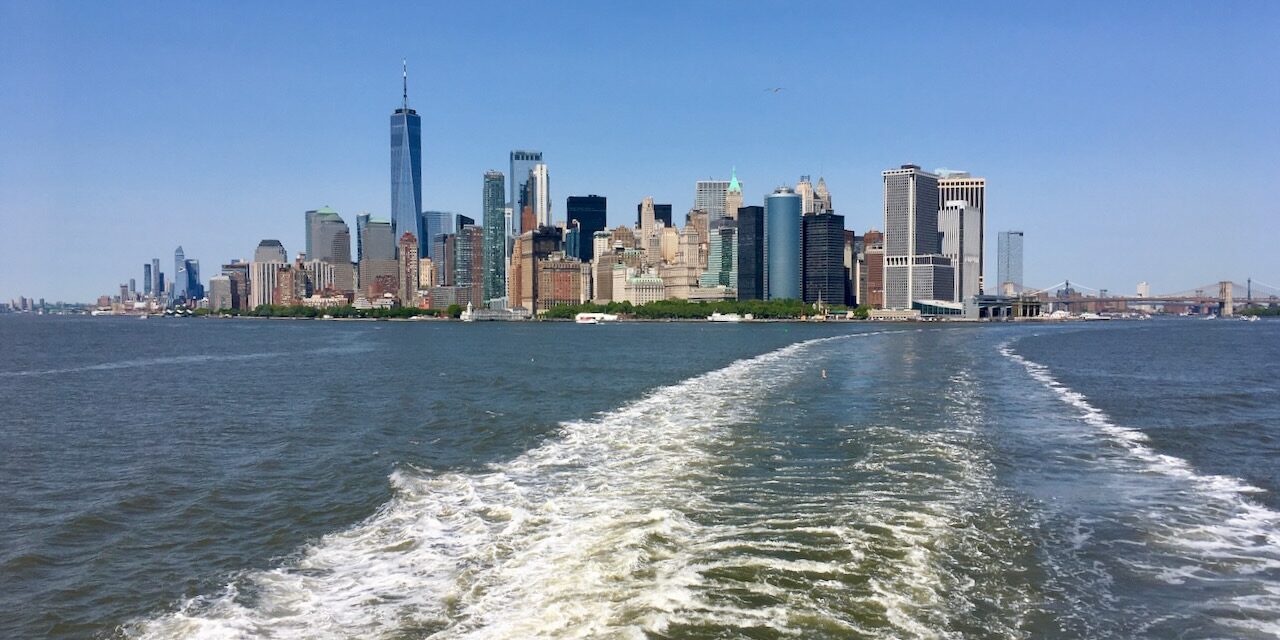New York, May 10, 2023
Jim Clifford and Judith Aissen

On the subway, en route from Brooklyn to Manhattan, we found ourselves at Bowling Green station. It was a lovely Spring day, so we thought: “Why not a ride out in the harbor?” To our delight, as we flowed with a large crowd onto the Staten Island Ferry, we noticed the name Dorothy Day above us.
For years, out in California, we’ve been receiving issues of The Catholic Worker, with its marvelous logo and wood block illustrations. It’s still addressed to Mike and Mildred Aissen, Judith’s parents, who were the original subscribers. Every few months– this welcome reminder of an older progressivism, Catholic and (for the Aissens) secular Jewish.
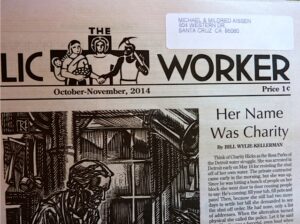

A week or so after our return to California, a lovely essay appeared in the New York Times. Its author, Dan Berry, rode the ferry around the time we did.
THE GOOD (EVEN SAINTLY) SHIP, DOROTHY DAY
While the Vatican decides whether Dorothy Day is worthy of sainthood, New Yorkers can ride on a Staten Island Ferry named in her honor.
By Dan Berry
Photos, Todd Heisler
NY Times. May 20, 2023

Last month, the Dorothy Day ferry took its inaugural run, drawing a large gathering at St. George Terminal in Staten Island.
As the newest Staten Island ferry grumbled across New York Harbor the other day, you could easily imagine the woman for whom it is named in contemplation by a window. Her dress plain, her white hair in a braided crown, her eyes seeking the divine in the green-gray waters.
The city ferries that provide free passage between Staten Island and Lower Manhattan are often christened after Staten Islanders of note: a high school football coach, a long-serving politician, a soldier killed in war. But no single descriptive fully captures Day, who died at 83 in 1980.
Journalist, reformer, anarchist, peace activist, Roman Catholic convert, co-founder of the Catholic Worker movement — and, perhaps, saint; the Vatican has declared her a “servant of God,” an initial step toward canonization. She is buried on Staten Island, where her religious conversion had taken root during solitary walks along its southern shores.
But solitude was not possible for last month’s celebration of the Dorothy Day ferry’s inaugural run. The large gathering at St. George Terminal in Staten Island included city officials and Catholic clerics, blue-uniformed officers and gray-haired pacifists, those sworn to uphold the law and those familiar with breaking it, at least in the name of civil disobedience.
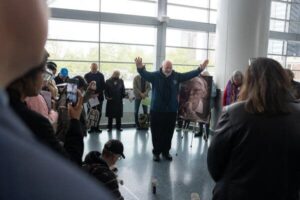
A brief prayer service was held at Whitehall Terminal in Lower Manhattan, after the ferry had traveled from Staten Island.
Among them was Martha Hennessy, 67, whose long white hair and long history of peace activism evoked her grandmother, Dorothy Day. Ms. Hennessy served nearly a year in prison for trespassing onto a submarine base in Georgia to participate in a symbolic, nonviolent protest against nuclear weapons.
“I’m a convicted felon,” said Ms. Hennessy, who had made a batch of chocolate-chip cookies for the day’s half-hour journey.
Through the mix of brochures handed out before the ceremony — this one about city ferries, that one about Day’s potential canonization — the secular and the sacred met. Combined, they provided a glimpse of Day’s life.
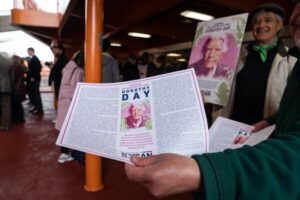
A mix of brochures was handed out before the ceremony, providing a glimpse of Day’s life.
How she settled in a Staten Island cottage in 1924 and two years later gave birth to a daughter, Tamar. How her embrace of Catholicism helped to end her common-law marriage to a biologist who rejected religion. How she and the social activist Peter Maurin founded the Catholic Worker, the radical lay movement committed to mercy, justice and providing hospitality to all in need.
How she remained a steadfast pacifist, protested against nuclear armament and was repeatedly jailed, the last time after picketing with striking farm workers in California, when she was 75. How she struggled with her flaws, doubts and depression, but kept a charted course.
“We have all known the long loneliness, and we have learned that the only solution is love and that love comes in community,” she once wrote.
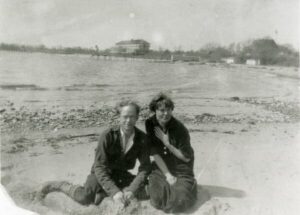
A circa 1925 photo of Dorothy Day with her partner, Forster Batterham, on a beach on Staten Island.Credit…via Marquette University
The ceremony included those obligatory forms of a municipal blessing — speeches — including one by the city’s transportation commissioner, Ydanis Rodriguez. He emphasized that Day’s call to treat every human being with “dignity and respect” included immigrants and workers.
“This is about more than riding a ferry,” Mr. Rodriguez, who was born in the Dominican Republic, said. “It’s to continue fighting for justice.”
Soon the Filthy Rotten System band was leading choruses of “If I Had a Hammer,” to the slight consternation of transportation officials worried about ferry schedules. But eventually the gates opened and the Dorothy Day, bedecked with red-white-and-blue bunting, received passengers for its first voyage to Manhattan.
The vessel shuddered, as if shaking off the shackles of land, and pulled away.
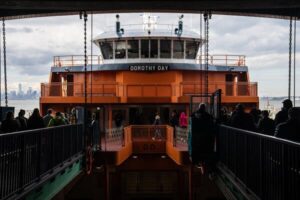
The ferry, at a cost of $85 million, can hold 4,500 passengers.
It will remain once of the eternal mysteries what Day might have made of an $85 million, 4,500-passenger ferry named after her.
Would she have given that withering “look” of hers, suggesting she had no time for such nonsense? Would she have repeated the famous admonition often attributed to her? (“Don’t call me a saint. I don’t want to be dismissed that easily.”)
Or would she have welcomed the moment as an opportunity to promote peace, nuclear disarmament and the message to love one another?

In the winter of 1927, Day boarded a ferry to Staten Island and wrote about her experience: “A most consuming restlessness was upon me so that I walked around and around the deck of the ferry, almost groaning in anguish of spirit.”
Now, several afternoons after its inaugural run, the Dorothy Day was taking its turn as just another one of the orange-and-blue behemoths that depart from St. George Terminal nearly 60 times a day. Gone was all the bunting, and the brackish waters had begun to streak the new windows.
The gate at the stern rose up and the 320-foot-long Dorothy Day groaned free from its wood-slatted berth. It rumbled into the harbor, where buoys bobbed, freighters glided and the impossible Manhattan skyline defined the horizon.
On the upper and middle decks, dozens of tourists had secured positions for the best views of the Statue of Liberty, still only a copper-green smudge in the distance. But on the lower deck, regulars seemed to have taken their places on benches. Some nodded off, some studied their cellphones and some lost themselves in the mesmerizing waters, just as Day once did.

Day lived intermittently on Staten Island and was baptized at a Catholic church in the Tottenville neighborhood.
For more than a half-century, she had lived intermittently on Staten Island, where she found space to decompress from the demands of editing The Catholic Worker newspaper and living in the Catholic Worker community on the Lower East Side — there are many dozen communities around the world — where she helped to provide food, housing and other services.
In the winter of 1927, for example, Day boarded the ferry to Staten Island and, as Paul Elie recounted in his book “The Life You Save May Be Your Own: An American Pilgrimage,” sat on the deck and wrote in her journal. The waters were restless, the air foggy, her mind troubled.
“A most consuming restlessness was upon me so that I walked around and around the deck of the ferry, almost groaning in anguish of spirit,” she later wrote. “Perhaps the devil was on the boat.”
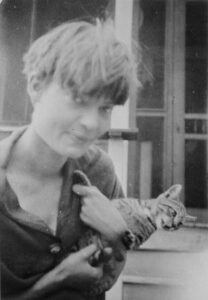
A circa 1925 photo of Day in front of a bungalow in Staten Island.
Two days later, Day went to a Catholic church in Staten Island’s Tottenville section and was baptized.
As Elie wrote, the ferry ride for Day could be “at once a retreat and a pilgrimage.” She breathed in the salt-scented air, imagined the far-off destinations of passing ships, felt the anxieties of urban life wash away. The ferry induced meditation.
On another ferry ride, in 1950, Day jotted down her thoughts: “The trip is so beautiful. The sky and water is so lovely in all its moods that I often find myself just thinking, and thinking ‘to the point’ on what has been going on down below the surface of my mind.”
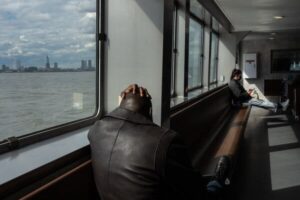
“The sky and water is so lovely in all its moods that I often find myself just thinking, and thinking ‘to the point’ on what has been going on down below the surface of my mind,” Day wrote about a ferry ride she took in 1950.
Now, on this ferry gliding across New York’s Upper Bay, you could almost see Dorothy Day by the window, apart from and a part of the waterborne crowd, taking in the awesome ordinary.
That harried man hurriedly eating a sloppy sandwich. Those sea gulls dodging and darting in the ferry’s wake. That mother chasing after her toddling toddler. Those two boys speaking in Spanish about their video game. The hum of the engines felt in the feet. The dance of the churning-white waters.
Unreal Manhattan became real as the Dorothy Day eased into its berth at Whitehall Terminal. Bells sounded, gates lowered and we made our way to solid ground, saints and sinners all.
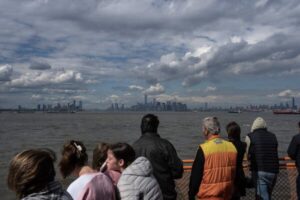
Day, who died in 1980 at the age of 83, is buried on Staten Island.
A few comments:
How wonderful that the new ferry is named after Dorothy Day. I’m an atheist through and through but greatly admire her, her work, those she inspired and most of all how she remains a beacon, dare I say it, like the Statue of Liberty, of all that Catholicism could have been and so very rarely has ever been. I’ve longed for a time when her liberation theology form of Catholicism would once again lead Catholics to a better place for them and for all of us. I’ll keep hoping.
I named my cat Dorothy Day. I hope she doesn’t have contempt for me. It’s been fun introducing people to her, and her, for the last 16 years. I guess that ship has sailed.You can also visit her grave on Staten Island and the little stretch of beachfront where the bungalow colony she lived in once was. Her bungalow was torn down by a developer in violation of city law but the hidden somewhat abandoned stretch of beach is still there and it feels like she is too
As a son (third generation, too) of Staten Island, I submit this question to whoever sees it: How surprised are you that my very conservative birthplace now has a ferry named after a pacifist and a leader in the workers’ rights movement?
I was a student in catholic schools in the Archdiocese of New York from 1958 until 1970 and naturally attended mass every Sunday and all religious holidays of obligation. I never heard a priest or nun mention Dorothy Day in any sermon or any conversation. I never sew a copy of the Catholic Worker. What I did hear was constant anti-communist rhetoric from priests and nuns and above all, from Francis Cardinal Spellman. I remember Cardinal Spellman blessing helicopters with holy water prior to their shipment to the Vietnam war in his capacity as Military Vicar. Dorothy Day was an anathema to the Catholic Church at the pinnacle of her activism in the very Archdiocese in which she worked. The current celebration of Day by the church reeks of hypocrisy and an attempt by the institutional Church to rewrite history and bathe itself in social justice and moral righteousness that was completely absent in Day’s time. Amazing how the past is so unpredictable!
As a Manhattanite, I sometimes take out-of-towners visiting me here… onto the affordable ferry to Staten Island and back. The trip’s views are often spectacular.
Listening to Dan read his essay reminded me of the NYC I love. The people, everyday New Yorkers make it the greatest city on earth. I had never heard of Dorothy Day, but I would have liked her. Thank you, Dan!

